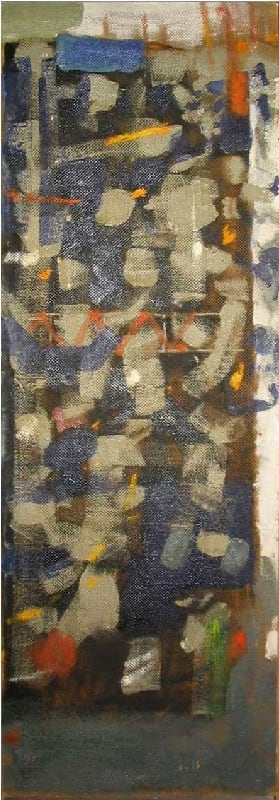Roger Hilton 1911-1975
Tall Cliff, 1957
Oil on board
81 x 26 cms
31 14/16 x 10 3/16 ins
31 14/16 x 10 3/16 ins
2237
Sold
This painting dates from a crucial moment in the development and promotion of British abstract painting, being painted the same year as two seminal exhibitions of abstraction, both of which...
This painting dates from a crucial moment in the development and promotion of British abstract painting, being painted the same year as two seminal exhibitions of abstraction, both of which included Hilton: Metavisual, Tachiste Abstract at the Redfern Gallery and Statements at the ICA.
Despite its title, Tall Cliff has a robust abstraction and a radical stripping away of any overt referants to the external world, in general, and landscape, in particular, that places it at the forefront of achievements in Britain. It's title is also significant, being characteristic of Hilton's use of poetic, descriptive titles at this moment and the suggestions they frequently give to landscape elements. Indeed prior to this period Hilton seldom made any reference to landscape in his titles.
Tall Cliff is typical, too, of the way in which painters such as Terry Frost, Patrick Heron, Peter Lanyon and Hilton strove to formulate an abstract painting that took as a starting point perceptual impressions, especially of landscape, as is indicated by the title. Indeed the format of the work may be compared to the extended dimensions, used by several artists of this generation including Heron, Lanyon and Bryan Wynter. The handling of paint also suggests their impact and there are echoes not just of the taches of Wynter but also Heron's works of a similiar format from 1956-57, which Hilton would have seen on his two extended stays with Heron during 1956.
Although Hilton's abstraction was already formed before his move to Cornwall in late 1956, in Tall Cliff the impact of painters in St Ives is evident and unsurprising. Painted just weeks after his arrival in Cornwall, Tall Cliff comes from a moment when Hilton's work took a leap forward, becoming even more improvisatory and experimental. It also displays his care at dating each work to the month so that his development could be traced from one work to the next. Indeed the present painting, from April 1957, is in marked contrast to another work from his first months in Cornwall, the Tate's January 1957. Whereas the Tate's work has a reduced palette and broad areas of colour the present work is constructed from small touches of paint in a wide variety of colours.
Despite its title, Tall Cliff has a robust abstraction and a radical stripping away of any overt referants to the external world, in general, and landscape, in particular, that places it at the forefront of achievements in Britain. It's title is also significant, being characteristic of Hilton's use of poetic, descriptive titles at this moment and the suggestions they frequently give to landscape elements. Indeed prior to this period Hilton seldom made any reference to landscape in his titles.
Tall Cliff is typical, too, of the way in which painters such as Terry Frost, Patrick Heron, Peter Lanyon and Hilton strove to formulate an abstract painting that took as a starting point perceptual impressions, especially of landscape, as is indicated by the title. Indeed the format of the work may be compared to the extended dimensions, used by several artists of this generation including Heron, Lanyon and Bryan Wynter. The handling of paint also suggests their impact and there are echoes not just of the taches of Wynter but also Heron's works of a similiar format from 1956-57, which Hilton would have seen on his two extended stays with Heron during 1956.
Although Hilton's abstraction was already formed before his move to Cornwall in late 1956, in Tall Cliff the impact of painters in St Ives is evident and unsurprising. Painted just weeks after his arrival in Cornwall, Tall Cliff comes from a moment when Hilton's work took a leap forward, becoming even more improvisatory and experimental. It also displays his care at dating each work to the month so that his development could be traced from one work to the next. Indeed the present painting, from April 1957, is in marked contrast to another work from his first months in Cornwall, the Tate's January 1957. Whereas the Tate's work has a reduced palette and broad areas of colour the present work is constructed from small touches of paint in a wide variety of colours.
Provenance
Waddington Galleries, LondonPrivate Collection, London



